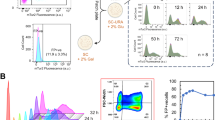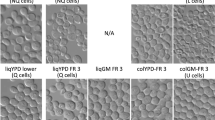Abstract
Heterokaryons (hets) of Candida albicans constructed by fusing protoplasts of complementing auxotrophs produce heterogeneous clones on minimal medium consisting of (i) a minority of slow-growing hets, (ii) a preponderance of non-growing, parental-type auxotrophic monokaryons, and (iii) some prototrophic monokaryons bearing hybrid nuclei. Hets grown at a given temperature within the range 25° C to 41° C replate with higher efficiencies at any lower temperature and exhibit progressively declining plating efficiencies as plate temperatures increase beyond that at which they were initially grown. Neither auxotrophic nor prototrophic monokaryons show such responses. Growth of colonies produced by hets, wild-type strains or prototrophic hybrid monokaryons is stimulated by temperatures in the order, 37° C > 30° C > 41° C > 25° C. However, the proportion of hets to auxotrophic monokaryons within individual net clones increases directly from 25° C to 41° C. Though this pattern obtains whether colonies are compared at equivalent sizes or ages, het frequencies decline as colonies age at all temperatures. Appearance of hybrid monokaryons within het clones is unaffected by growth temperature. The relationships of temperatures to plating efficiencies and stabilities of hets are independent of the natures of their complementing auxotrophies or the wild-type backgrounds of their nuclear components and are, therefore, functions of heterokaryosis per se. Modifications of these relationships by selective metabolic antagonists or by growth of hets on different preand post-plating carbon sources indicate that they reflect temperature-dependent properties of mitochondria which are peculiar to hets.
Similar content being viewed by others
References
Arseneau, A. J. & Gregory, K. F., 1981. Sequential cold sensitive mutations in Aspergillus fumigatus. III mechanism of cold sensitivity. Can. J. Microbiol. 27:304–310.
Bandlow, W. & Kandewitz, F., 1974. Action of ethidium bromide on mitochondrial DNA in the petite-negative yeast Schizosaccharomyces pombe. Molec. Gen. Genet. 131:333–338.
Fukuhara, H. & Kujawa, C., 1970. Selective inhibition of the in vivo transcription of mitochondrial DNA by ethidium bromide and by acriflavin. Biochem. Biophys. Res. Commun. 41:1002–1008.
Lambowitz, A. M, Chua, N. H. & Luck, D. L., 1976. Mitochondrial ribosome assembly in Neurospora. Preparation of mitochondrial ribosomal precursor particles, site of synthesis of mitochondrial ribosomal proteins and studies of the poky mutant. J. Mol. Biol. 54:56–74.
Lloyd, D., 1974. The mitochondria of microorganisms, p. 553, Academic Press, New York.
Mhler, H. R. & Johnson, J., 1979. Specific effects of nalidixic acid on mitochondrial gene expression in Saccharomyces cerevisiae. Molec. Gen. Genet. 176:25–81.
Picard-Bennoun, M. & Le Coze, D., 1980. Search for ribosomal mutants in Podospora anserina: Genetic analysis of cold sensitive mutants. Genet. Res. 36:289–298.
Sarachek, A., 1977. Ergosterol enhanced reovery of mutagen treated Candida albicans. Z. allg. Mikrobiol. 17: 481–485.
Sarachek, A. & Rhoads, D. D., 1981. Production of heterokaryons of Candida albicans by protoplast fusions: effects of differences in proportions and regenerative abilities of fusion partners. Current Genet. 4:221–222.
Sarachek, A. & Rhoads, D. D., 1982. Cold-sensitivity oif heterokaryons of Candida albicans. Sabouraudia 20: 251–260.
Sarachek, A., Rhoads, D. D. & Schwarzhoff, R. H., 1981. Hybridization of Candida albicans through fusion of protoplasts. Arch. Microbiol. 129:1–8.
Schatz, G., Groot, G. S., Mason, T., Rouslin, W., Wharton, D. C. & Salitzgaber, J., 1972. Biogenesis of mitochondrial inner membranes in bakers yeast. Fed. Proc. 31:21–29.
Singh, A., Mason, T. L. & Zimmerman, R. A., 1978. A cold sensitive cytoplasmic mutation of Saccharomyces cerevisiae affecting assembly of the mitochondrial 50S ribosomal subunit. Molec. Gen. Genet. 161:143–152.
Ursic, D. & Davis, J., 1979. A cold sensitive mutant of Saccharomyces cerevisiae defective in ribosome processing. Molec. Gen. Genet. 175:313–324.
Author information
Authors and Affiliations
Rights and permissions
About this article
Cite this article
Sarachek, A., Rhoads, D.D. Effects of growth temperatures on plating efficiencies and stabilities of heterokaryons of Candida albicans . Mycopathologia 83, 87–95 (1983). https://doi.org/10.1007/BF00436888
Issue Date:
DOI: https://doi.org/10.1007/BF00436888




